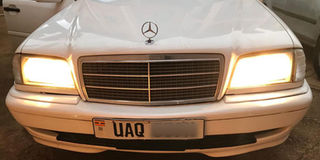Headlight maintenance tips that go a long way

A good bulb from a reputable manufacturer can last anywhere from two to three years. PHOTO BY MARK KAWALYA
Your car is equipped with a pair of headlights that are instrumental for nighttime driving. Lights also play a key role when it is raining or during foggy conditions where visibility is low.
Many drivers appreciate the need for regular maintenance of their cars. They carry out oil changes religiously, monitor tyre pressure, replace different automotive filters on schedule and give due attention to the health of their cars transmission.
However cars headlights are often one of the most neglected parts of the car despite the crucial role they play. It is often assumed that since the lights power on and off when they are needed, they need no attention.
Yellowed headlights
Most cars frontal lights are made from an acrylic plastic that comes with a protective clear top coating that prevents them from turning foggy due to oxidation that occurs from repeated exposure to the sun’s rays. However, over time, this coating wears off and the once shinny lights turn foggy.
Many Ugandan drivers are not concerned with foggy lights not realizing that this can be hazardous as foggy lights can reduce a vehicles illumination by up to 50 per cent.
Deo Lutwama, a mechanic, says there are procedures that can be used to restore foggy headlights. This can cost anywhere between Shs50,000 to Shs80,000 depending on the procedure to be used.
Most mechanics will sand and wax the lights with a rubbing compound which eliminates the yellow layer. You can also buy a headlight restoration kit, which has instructions and applications to use.
Adjust the focus of your bulbs
Did you know that just like a flashlight, your car’s headlights can be adjusted to focus on different levels of the road?
According to Lutwama, overtime, the focus of your lights may shift due to bumpy driving conditions that can cause the bulbs to shift in their sockets. It is, therefore, a common occurrence for drivers to drive with misaligned headlight focus, which reduce visibility.
Lutwama adds that you can carry out a simple test to determine if your headlights are not focused. In the evening, park your car while facing a wall fence. Turn on the car’s lights and notice the projection of the lights on the wall.
They should have symmetry and light up a focused area on the wall. If they are not, you can fix this. Pop open your bonnet and locate the headlight adjusting knobs and turn them to fix this. These knobs are normally located behind the lights.
However, be careful as headlights become hot very quickly. If you are not comfortable to adjust these yourself, then your mechanic should handle it.
Replace headlight bulbs
Headlight bulbs are prone to blowing and this may happen more often if you replace them with cheap bulbs from unknown manufacturers. A good bulb from a reputable manufacturer can last anywhere from two to three years.
Always ensure that you check the wattage of your old bulbs and only replace them with bulbs with the same watts. Do not touch bulbs with your naked hands as the oils in the bulbs will burn out the bulb after it has been installed and switched on.
Do not be tempted to drive at night with only one functional light. Not only is this dangerous, it is irresponsible as you might endanger the lives of other road users since it is easy for on-coming traffic to confuse your car with a motorcycle at night if one of your lights is not working.
An oncoming driver could then over take thinking there is enough space to accommodate their car and ‘your motorcycle’ only to realise too late of the vehicle driving towards them.
Headlight driving modes and when to use them
Every car has two headlight driving modes, which are the low beam and high beam locally known as full lights. While they can each be switched on by a simple flickering of a switch, they are designed to be used with some consideration of the environment within which one is driving.
Low beam lighting
This is the normal car lighting setting designed to be used as the main lighting mode while driving. They are typically used in dim driving conditions where secondary lighting is provided by other cars or street lighting.
They have a short-range focus and their illumination does not light up far off places. They are angled towards the ground and will not blind other drivers hence their use as the primary lighting mode.
High beam lighting
This lighting mode is useful when driving in purely dark environments such as on rural roads where there is no lighting from other drivers or streetlights.
The beams have a long-range focus and are angled upwards to illuminate far off objects on the road. According to Josiah Lubega, a driving instructor, full lights need to be used sparingly as they can blind other drivers.
He says drivers should be able to alternate between low and high beams continuously while driving as driving conditions keep changing on various sections of the road.




